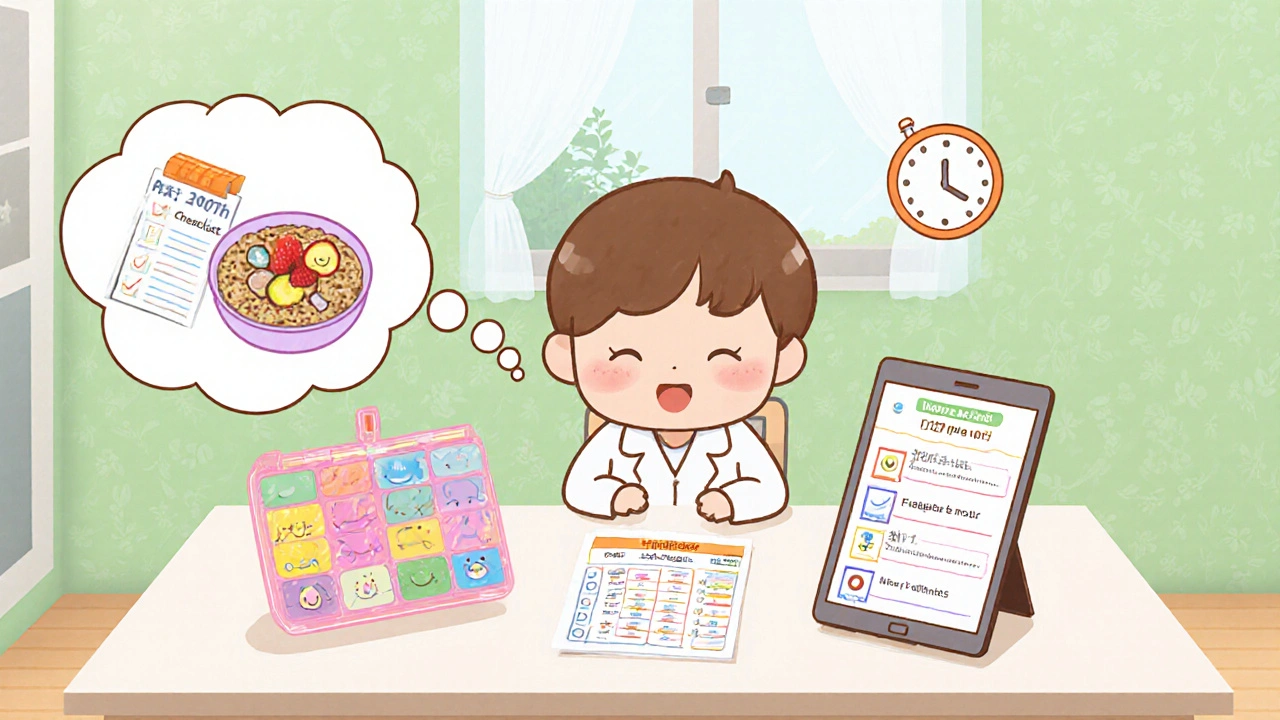Managing Parkinson's disease can feel like juggling many moving parts, but the most powerful tool in the kit is often simple: education. When patients truly understand how Carbidopa-Levodopa works and what to watch for, they’re far more likely to stick to the regimen, avoid complications, and keep their quality of life high.
What is Carbidopa-Levodopa?
Carbidopa-Levodopa is a combination medication used as the first‑line treatment for Parkinson's disease. It pairs two agents: Levodopa, a precursor that the brain converts into dopamine, and Carbidopa, which blocks peripheral breakdown of levodopa, allowing more of the drug to reach the brain. The result is a smoother, more predictable increase in dopamine levels, which helps reduce the motor symptoms that characterize Parkinson's.
Why Patient Education Is the Linchpin of Success
Even the best‑designed drug can fall short if patients don’t know how to take it correctly. Studies from the Movement Disorder Society show that patients who receive structured education are up to 30 % more adherent and experience fewer dose‑related side effects. Education tackles three core challenges:
- Adherence: Understanding the importance of taking the medication at the same times each day prevents fluctuations in dopamine that can trigger “off” periods.
- Side‑effect management: Recognizing early signs of nausea, orthostatic hypotension, or Dyskinesia (involuntary movements) enables timely dose adjustments.
- Safe titration: Patients who know how dose changes are made are less likely to make abrupt alterations that could cause severe motor swings.
Core Education Topics Every Clinician Should Cover
When you sit down with a newly diagnosed patient, aim to hit these six pillars. Each one can be delivered in a brief conversation, a printed handout, or a digital app-choose the format that matches the patient’s learning style.
- Timing and Consistency: Explain why doses should be spaced evenly (usually every 4‑6 hours) and why missing a dose should be followed by a specific catch‑up strategy.
- Interaction with Food: High‑protein meals can compete with levodopa for transport across the gut wall. Advise taking the medication 30 minutes before meals or 1 hour after a protein‑rich dinner.
- Managing Nausea and Orthostatic Symptoms: Take the first dose with a small snack and rise slowly from sitting or lying positions.
- Recognizing Dyskinesia: Teach patients to log any involuntary movements, noting timing relative to dose, so the neurologist can fine‑tune the regimen.
- When to Call the Doctor: Set clear thresholds-e.g., sudden increase in “off” time, severe nausea lasting >2 days, or new hallucinations.
- Adjunct Therapies: Briefly discuss how MAO-B inhibitors (e.g., selegiline) or COMT inhibitors (e.g., entacapone) can be added later to smooth out motor fluctuations.

Practical Strategies for Clinicians
Education isn’t a one‑off lecture; it’s an ongoing dialogue. Here are three evidence‑based tactics that fit into a busy clinic schedule:
- Teach‑Back Method: After explaining a concept, ask the patient to repeat it in their own words. This instantly reveals gaps.
- Multimodal Materials: Combine a concise printed sheet (bullet points, visual dosing schedule) with a short video you can upload to a patient portal. A visual cue often sticks better than text alone.
- Digital Pill‑Tracking Apps: Recommend free apps that send reminders and allow patients to log symptoms. Data can be uploaded before the next appointment, giving you a real‑time adherence snapshot.
Home Management Tips for Patients and Caregivers
Even the smartest patient can stumble on the daily grind. Empower them with these at‑home hacks:
- Pill Organizer: Use a weekly compartmentalizer with separate sections for morning, noon, and evening doses. Color‑code each compartment to match the prescription bottle.
- Symptom Diary: Keep a simple table noting dose time, “on” vs “off” periods, and any side effects. Review the diary with the neurologist every 3 months.
- Meal Planning: Prepare a low‑protein breakfast (e.g., oatmeal with fruit) on days when the first dose is taken. Reserve high‑protein foods for later meals.
- Backup Supply: Store an extra month’s worth of medication in a safe, temperature‑controlled place. Sudden pharmacy delays can otherwise interrupt therapy.
- Emergency Action Plan: Write down the doctor’s phone number, the current dose, and the steps to take if severe “off” time or dyskinesia occurs.
Common Pitfalls and How to Avoid Them
Even with good education, patients often slip into habits that undermine treatment. Recognize these red flags early:
- Missing Doses: Skipping a dose and then doubling the next one can cause sudden dopamine spikes and dyskinesia. Reinforce the “take half the missed dose” rule.
- Abrupt Dose Changes: Patients sometimes decide to cut the dose on their own when they feel “too wired.” Any reduction should be done gradually under medical supervision.
- Drug Interactions: Over‑the‑counter antihistamines and certain antidepressants can exacerbate side effects. Create a medication reconciliation sheet that the patient reviews with each pharmacy visit.
- Ignoring Early Side Effects: Nausea often improves after the first week. If patients stop the drug too soon, they lose the long‑term benefit. Provide reassurance and a short‑term anti‑emetic plan.
Quick‑Reference Checklist
| Topic | Key Message | Patient Action |
|---|---|---|
| Timing | Take doses every 4‑6 hours, same times each day. | Set alarms; use pill organizer. |
| Food Interaction | High‑protein meals can block absorption. | Take medication 30 min before or 1 hr after protein. |
| Side‑Effect Log | Record nausea, dizziness, dyskinesia. | Use symptom diary or app. |
| When to Call | Severe “off” time, sudden dyskinesia, hallucinations. | Dial doctor’s office immediately. |
| Adjuncts | MAO‑B or COMT inhibitors may be added later. | Discuss with neurologist at follow‑up. |
Frequently Asked Questions
Can I take Carbidopa-Levodopa with my regular breakfast?
It’s best to take the first dose on an empty stomach, about 30 minutes before you eat. If you need to take it with food, choose a low‑protein option like toast or fruit.
What should I do if I miss a dose?
Take the missed dose as soon as you remember, unless it’s less than 2 hours before your next scheduled dose. In that case, take half the missed amount and resume the regular schedule.
Why do I sometimes feel “wobbly” after a dose?
That sensation is often low blood pressure (orthostatic hypotension). Stand up slowly, stay hydrated, and discuss a possible dose tweak with your doctor.
Is it safe to combine Carbidopa-Levodopa with other Parkinson’s drugs?
Yes, many patients later add MAO-B inhibitors or COMT inhibitors to smooth out fluctuations. Always have a neurologist coordinate the combination to avoid excess dopamine.
How often should I see my neurologist after starting therapy?
The first follow‑up is usually 4‑6 weeks to assess dose tolerance, then every 3‑6 months once you’re stable. Bring your symptom diary to each visit.
Effective Parkinson’s management isn’t just about the pill; it’s about the person taking it. By weaving clear, practical education into every visit, clinicians can turn a complex drug regimen into a predictable, manageable routine that keeps patients moving forward.



Comments
Great overview of the basics and it feels hopeful for anyone starting on Carbidopa‑Levodopa. Simple steps like timing and a food tip can really change day‑to‑day life. Keep spreading the word
The guide, while exhaustive, neglects the socioeconomic barriers that many patients face in adhering to such regimented schedules. It assumes universal access to digital pill‑tracking apps and printed handouts, ignoring the reality of limited internet connectivity in rural areas. Moreover, the emphasis on high‑protein diet management does not account for cultural dietary habits where protein is a staple. The recommendation to take medication on an empty stomach may exacerbate nausea in patients already struggling with gastrointestinal issues. There is no discussion about insurance coverage for adjunct therapies like MAO‑B or COMT inhibitors, which can be cost‑prohibitive. The suggested symptom diary, while useful, lacks guidance on how to interpret the data without a specialist present. Overall, the guide feels more like a checklist for well‑resourced clinics rather than a universal patient education tool.
I love how the guide breaks things down into bite‑size steps 😊. The tip about low‑protein breakfast really helped me not feel "wobbly" after my first dose. I do sometimes forget to log my side effects, but the app reminder saved me. Thanks for the clear language, it made me feel less scared about titration.
I commend the thoroughness of this guide and would like to highlight several points that merit further emphasis. First, the pharmacokinetic rationale behind the inhibition of peripheral decarboxylation by carbidopa is essential for clinicians to convey, as it underpins the need for precise dosing intervals. Second, the interplay between dietary amino acids and levodopa transport across the intestinal mucosa should be illustrated with a simple diagram to reinforce patient comprehension. Third, the "teach‑back" method, while mentioned, deserves a dedicated paragraph outlining structured prompts that can be used in the clinic setting. Fourth, clinicians must address orthostatic hypotension not only with postural advice but also by reviewing concomitant antihypertensive medications, as polypharmacy is common in this population. Fifth, the guideline could incorporate a brief discussion on the role of serotonergic medications and their potential to exacerbate dyskinesia when combined inadvertently with levodopa. Sixth, the importance of establishing a clear emergency action plan cannot be overstated; patients should be provided with a pocket card containing dose, symptom thresholds, and direct contact numbers. Seventh, while the checklist is useful, it would benefit from a column indicating typical timeframes for each action, such as "review medication list every 6 months". Eighth, the suggestion to use a digital app is prudent, yet the guide should caution users about data privacy and the need for HIPAA‑compliant platforms. Ninth, caregivers often serve as the primary observers of motor fluctuations, so the guide should explicitly advise clinicians to involve them in education sessions. Tenth, the recommendation to store a backup supply is wise, but storage conditions-cool, dry, and out of direct sunlight-should be specified to maintain drug stability. Eleventh, when discussing adjunct therapies, it would be valuable to outline a step‑wise algorithm for when to introduce MAO‑B versus COMT inhibitors based on the patient's "off" time percentage. Twelfth, the potential for hallucinations with high dopamine levels warrants screening for underlying cognitive impairment before dose escalation. Thirteenth, the guide should remind clinicians to reassess the need for anticholinergic agents, which may be unnecessary once levodopa optimization is achieved. Fourteenth, a brief mention of the emerging role of continuous dopaminergic infusion pumps could prepare patients for future therapeutic options. Finally, the conclusion should reinforce that patient education is an ongoing partnership, not a one‑time lecture, and that regular follow‑up appointments are crucial for sustained adherence and quality of life.
The pill organizer tip is gold. It makes dosing less stressful.
From a pharmacodynamic perspective, the synergistic effect of carbidopa on levodopa bioavailability cannot be overstated. However, note the missmatch between the suggested 4‑6 hour interval and real‑world patient adherence patterns, especially in populations with erratic work shifts. Also, consider the impact of CYP2D6 polymorphisms when adding adjuncts; this can modulate the half‑life of levodopa metabolites. Lastly, the guide could benefit from a brief nod to levodopa‑induced neuroplasticity as a factor in long‑term motor complications.
Really appreciate the supportive tone throughout the guide. The symptom diary suggestion is something I use with my mom and it’s helped us catch early dyskinesia trends. Also, reminding patients to stand up slowly can prevent those scary drops in blood pressure. The backup supply advice is a lifesaver if a pharmacy runs out. Thanks for packing so much practical advice in a readable format.